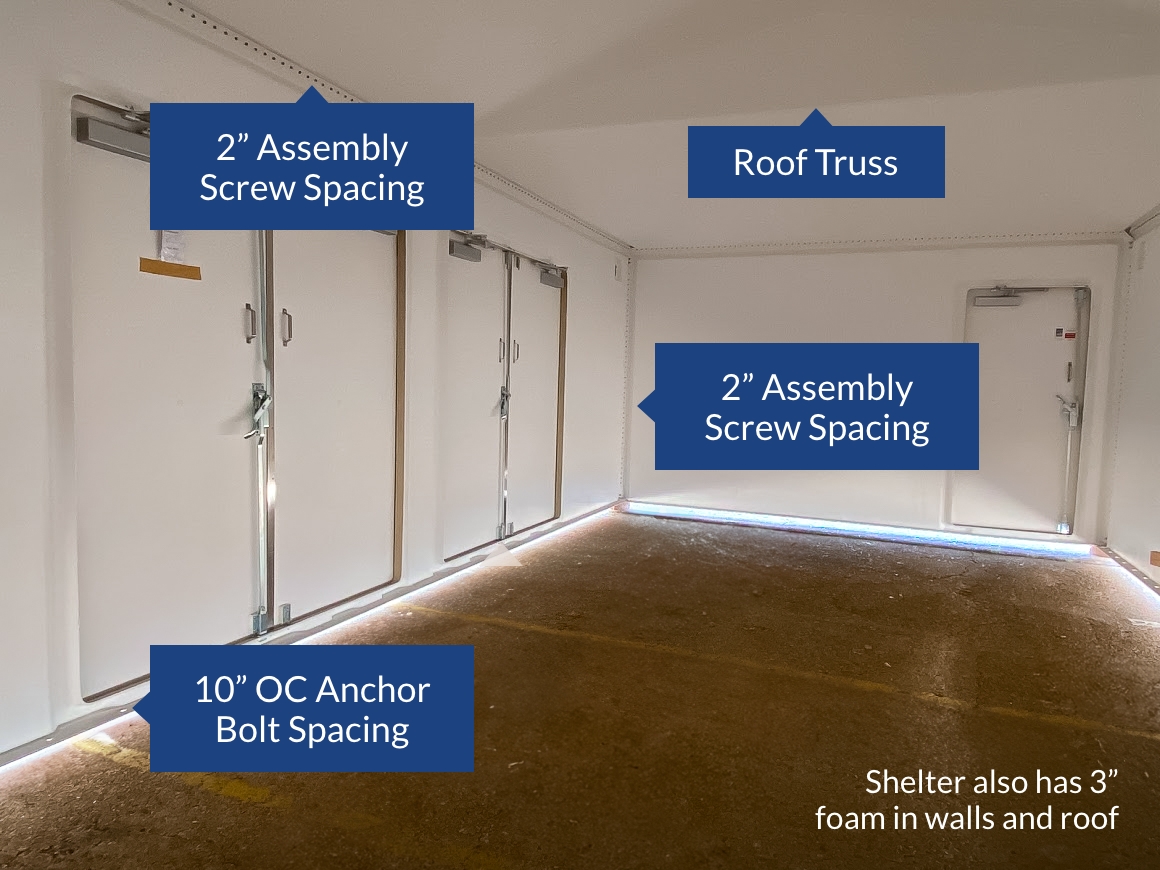Improving a Shelter's Strength
How Shelter Works Builds Stronger Fiberglass Enclosures
Environmental forces, like wind and snow loads, can pose significant threats to small buildings and enclosures. High winds can exert substantial pressure, potentially causing structural damage and wall failure. The accumulation of snow and ice adds considerable weight to roofs and other structural elements, which can lead to collapse if the structure is not designed to handle these loads. While seismic activity is also a concern, it does not tend to drive design decisions in a fiberglass (FRP) shelter due to FRP’s ability to wobble when needed.
The thoughtful design of a Shelter Works fiberglass enclosure is evident in its long-lasting performance. Our fiberglass shelters are engineered and manufactured for exceptional strength, durability, and longevity. While our standard assembly meets the criteria for many building standards, one or more of these additional structural supports may be necessary in areas prone to weather related stressors.
Engineered Solutions for Enhanced Structural Integrity

Shelter features include a roof truss, 3 in. foam in walls and ceiling, 2 in. assembly fastener spacing, and 10 in. OC anchor bolt spacing. Shelter rated for 40 PSF roof load and 140 MPH wind speed
Assembly Screw Spacing – Assembly screws at wall-to-wall and wall-to-roof connections hold the shelter together. The Shelter Works standard assembly comes with 12” OC screw spacing. Decreasing the spacing between assembly screws helps maintain the alignment and rigidity of walls under dynamic loads. Increasing the quantity of assembly screws is the most cost-effective way to increase a shelter’s wind resistance.
Foundation Anchor Bolt Spacing – For shelters attaching to concrete pads, we provide pre-drilled holes in the base flange to guide the installer on where to place the anchoring bolts. The standard spacing for Shelter Works’ anchor bolts is 24” OC. However, for shelters in areas with higher wind load requirements, we reduce the spacing between foundation screws to 12” OC. This increase in anchor bolts enhances the shelter’s ability to resist lateral movements caused by wind and other environmental factors, ensuring the shelter remains securely anchored.
Foam Thickness – The foam core in fiberglass sandwich construction acts like the web of an I-beam, providing shear strength while the fiberglass skins handle tensile and compressive forces. A thicker foam core enhances this effect, improving the wall's structural performance. This helps to resist bending and deformation under load, contributing to a more stable and robust structure while improving the shelter’s energy efficiency.
Wood in Walls – Oriented Strand Board (OSB) acts as a reinforcing layer, working in conjunction with the fiberglass skins and foam core to enhance the overall rigidity of the wall. It helps to distribute loads more evenly across the surface, reducing stress concentrations and helping to prevent localized failures.
OSB can support heavier loads, making the wall more suitable for applications where there is a higher load-bearing capacity. This is particularly important for resisting lateral forces like wind and supporting heavier equipment like air conditioners.
Trusses – Roof trusses are included in larger buildings and shelters located in areas with higher snow load requirements. trusses help to evenly distribute the weight of the roof load, improving shelter stability and strength. They are effective at resisting forces from both snow loads and wind speed. Shelter Works roof trusses are built to last, contributing to the overall durability and lifespan of the shelter.
Center Support Posts - A center support post, used in our largest shelters, significantly enhances a building's load-bearing capacity and structural stability. A Center support post reduces stress on outer walls and prevents sagging. It also increases the structure's stability, helping it resist wind, and enhances overall rigidity, making the building less prone to deformation.
With these customizable enhancements, Shelter Works ensures that our fiberglass enclosures meet the highest standards of performance and durability. By adjusting assembly screw spacing, foundation screw spacing, foam core thickness, and incorporating OSB reinforcement and roof trusses, we can design our shelters to withstand the most demanding environmental conditions. Whether facing high winds, heavy snow loads, or seismic activity, our shelters provide unparalleled protection and longevity. You can trust Shelter Works to deliver a shelter that not only meets but exceeds your expectations for strength and reliability.

